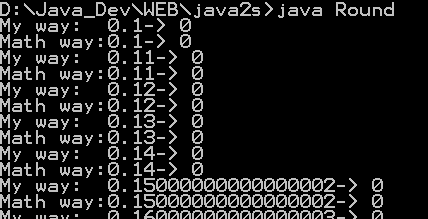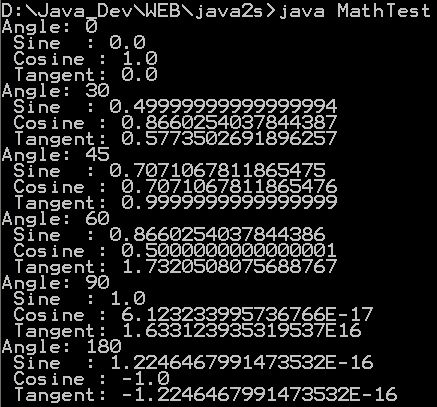Demonstrate our own version round()

/*
* Copyright (c) Ian F. Darwin, http://www.darwinsys.com/, 1996-2002.
* All rights reserved. Software written by Ian F. Darwin and others.
* $Id: LICENSE,v 1.8 2004/02/09 03:33:38 ian Exp $
*
* Redistribution and use in source and binary forms, with or without
* modification, are permitted provided that the following conditions
* are met:
* 1. Redistributions of source code must retain the above copyright
* notice, this list of conditions and the following disclaimer.
* 2. Redistributions in binary form must reproduce the above copyright
* notice, this list of conditions and the following disclaimer in the
* documentation and/or other materials provided with the distribution.
*
* THIS SOFTWARE IS PROVIDED BY THE AUTHOR AND CONTRIBUTORS ``AS IS''
* AND ANY EXPRESS OR IMPLIED WARRANTIES, INCLUDING, BUT NOT LIMITED
* TO, THE IMPLIED WARRANTIES OF MERCHANTABILITY AND FITNESS FOR A PARTICULAR
* PURPOSE ARE DISCLAIMED. IN NO EVENT SHALL THE AUTHOR OR CONTRIBUTORS
* BE LIABLE FOR ANY DIRECT, INDIRECT, INCIDENTAL, SPECIAL, EXEMPLARY, OR
* CONSEQUENTIAL DAMAGES (INCLUDING, BUT NOT LIMITED TO, PROCUREMENT OF
* SUBSTITUTE GOODS OR SERVICES; LOSS OF USE, DATA, OR PROFITS; OR BUSINESS
* INTERRUPTION) HOWEVER CAUSED AND ON ANY THEORY OF LIABILITY, WHETHER IN
* CONTRACT, STRICT LIABILITY, OR TORT (INCLUDING NEGLIGENCE OR OTHERWISE)
* ARISING IN ANY WAY OUT OF THE USE OF THIS SOFTWARE, EVEN IF ADVISED OF THE
* POSSIBILITY OF SUCH DAMAGE.
*
* Java, the Duke mascot, and all variants of Sun's Java "steaming coffee
* cup" logo are trademarks of Sun Microsystems. Sun's, and James Gosling's,
* pioneering role in inventing and promulgating (and standardizing) the Java
* language and environment is gratefully acknowledged.
*
* The pioneering role of Dennis Ritchie and Bjarne Stroustrup, of AT&T, for
* inventing predecessor languages C and C++ is also gratefully acknowledged.
*/
/**
* Demonstrate our own version round().
* @author Ian F. Darwin, http://www.darwinsys.com/
* @version $Id: Round.java,v 1.4 2004/03/06 22:17:32 ian Exp $
*/
public class Round {
/** We round a number up if its fraction exceeds this threshold. */
public static final double THRESHOLD = 0.54;
/*
* Round floating values to integers.
* @Return the closest int to the argument.
* @param d A non-negative values to be rounded.
*/
static int round(double d) {
if (d < 0) {
throw new IllegalArgumentException("Value must be non-negative");
}
int di = (int)Math.floor(d); // integral value below (or ==) d
if ((d - di) > THRESHOLD) {
return di + 1;
} else {
return di;
}
}
public static void main(String[] argv) {
for (double d = 0.1; d<=1.0; d+=0.01) {
System.out.println("My way: " + d + "-> " + round(d));
System.out.println("Math way:" + d + "-> " + Math.round(d));
}
}
}
Related examples in the same category
| 1. | Absolute value | | |
| 2. | Find absolute value of float, int, double and long using Math.abs | | |
| 3. | Find ceiling value of a number using Math.ceil | | |
| 4. | Find exponential value of a number using Math.exp | | |
| 5. | Find floor value of a number using Math.floor | | |
| 6. | Find minimum of two numbers using Math.min | | |
| 7. | Find power using Math.pow | | |
| 8. | Find square root of a number using Math.sqrt | | |
| 9. | Find natural logarithm value of a number using Math.log | | |
| 10. | Find maximum of two numbers using Math.max | | |
| 11. | Get the power value | |  |
| 12. | Using the Math Trig Methods | |  |
| 13. | Using BigDecimal for Precision | |  |
| 14. | Demonstrate a few of the Math functions for Trigonometry | |  |
| 15. | Exponential Demo | |  |
| 16. | Min Demo | | |
| 17. | Basic Math Demo | |  |
| 18. | Using strict math in applications | |  |
| 19. | Conversion between polar and rectangular coordinates | | |
| 20. | Using the pow() function | | |
| 21. | Using strict math at the method level | | |
| 22. | Calculating hyperbolic functions | | |
| 23. | Calculating trigonometric functions | | |
| 24. | Weighted floating-point comparisons | | |
| 25. | Solving right triangles | | |
| 26. | Applying the quadratic formula | | |
| 27. | Calculate the floor of the log, base 2 | | |
| 28. | Greatest Common Divisor (GCD) of positive integer numbers | | |
| 29. | Least Common Multiple (LCM) of two strictly positive integer numbers | | |
| 30. | Moving Average | | |
| 31. | Make Exponention | | |
| 32. | Caclulate the factorial of N | | |
| 33. | Trigonometric Demo | |  |
| 34. | Complex Number Demo | | |
| 35. | sqrt(a^2 + b^2) without under/overflow | | |
| 36. | Returns an integer hash code representing the given double array value. | | |
| 37. | Returns an integer hash code representing the given double value. | | |
| 38. | Returns n!. Shorthand for n Factorial, the product of the numbers 1,...,n as a double. | | |
| 39. | Returns n!. Shorthand for n Factorial, the product of the numbers 1,...,n. | | |
| 40. | Returns the hyperbolic sine of x. | | |
| 41. | Contains static definition for matrix math methods. | | |
| 42. | For a double precision value x, this method returns +1.0 if x >= 0 and -1.0 if x < 0. Returns NaN if x is NaN. | | |
| 43. | For a float value x, this method returns +1.0F if x >= 0 and -1.0F if x < 0. Returns NaN if x is NaN. | | |
| 44. | Normalize an angle in a 2&pi wide interval around a center value. | | |
| 45. | Normalizes an angle to a relative angle. | | |
| 46. | Normalizes an angle to an absolute angle | | |
| 47. | Normalizes an angle to be near an absolute angle | | |
| 48. | Returns the natural logarithm of n!. | | |
| 49. | Returns the least common multiple between two integer values. | | |
| 50. | Gets the greatest common divisor of the absolute value of two numbers | | |
| 51. | Matrix manipulation | | |
| 52. | Returns exact (http://mathworld.wolfram.com/BinomialCoefficient.html) Binomial Coefficient | | |
| 53. | Returns a double representation of the (http://mathworld.wolfram.com/BinomialCoefficient.html) Binomial Coefficient | | |
| 54. | Returns the natural log of the (http://mathworld.wolfram.com/BinomialCoefficient.html) Binomial Coefficient | | |
| 55. | Returns the hyperbolic cosine of x. | | |
| 56. | Math Utils | | |
| 57. | Implements the methods which are in the standard J2SE's Math class, but are not in in J2ME's. | | |
| 58. | Utility methods for mathematical problems. | | |
| 59. | A math utility class with static methods. | | |
| 60. | Computes the binomial coefficient "n over k" | | |
| 61. | Log Gamma | | |
| 62. | Log Beta | | |
| 63. | Beta | | |
| 64. | Gamma | | |
| 65. | Factorial | | |
| 66. | Computes p(x;n,p) where x~B(n,p) | | |
| 67. | Returns the sum of two doubles expressed in log space | | |
| 68. | sigmod | | |
| 69. | sigmod rev | | |
| 70. | Numbers that are closer than this are considered equal | | |
| 71. | Returns the KL divergence, K(p1 || p2). | | |
| 72. | Returns the sum of two doubles expressed in log space | | |
| 73. | Returns the difference of two doubles expressed in log space | | |
| 74. | Is Prime | | |
| 75. | Statistical functions on arrays of numbers, namely, the mean, variance, standard deviation, covariance, min and max | | |
| 76. | This class calculates the Factorial of a numbers passed into the program through command line arguments. | |  |
| 77. | Calculates the Greatest Common Divisor of two numbers passed into the program through command line arguments. | | |
| 78. | Variance: the square of the standard deviation. | | |
| 79. | Population Standard Deviation | | |
| 80. | Returns from a static prime table the least prime that is greater than or equal to a specified value. | | |